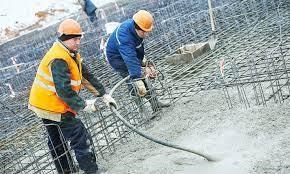Commercial concreting is an essential aspect of civil engineering in constructing roads, bridges, and a chemically combined mixture of cement, sharp stones, gravel, and water with other inert materials. Some of the inert materials serve as a filler or binder, depending on the component materials. Meanwhile, the inert materials are aggregates. Typical examples include brick chips, gravels, shells, sand, stoner chips, and other materials.

More so, concrete can be relatively inexpensive, especially when you factor in how durable it is and how much it can last against other building materials. But suppose we would be objective with our concrete construction materials. In that case, we must clearly state some of the advantages and disadvantages of the material. Mainly, as it serves the purpose of strength and durability, it also lacks specific attributes that other materials have.
There are many exciting benefits to why a building or project manager should choose a concrete material over other alternative building materials. For instance, concrete is moldable into different shapes, depending on the use. For example, modern concrete roads make use of small concrete structures to make an interlock system, which is small enough for the surface area to bear the weight of cars. In addition, there are closely arranged to give space for expansion.
Meanwhile, below are some of the classics that are available as part of commercial concreting solutions.
- High rise building
- Formwork
- Parking lots
- Car parks
- Retaining walls
- Ramps
- Bulk pours
- Concrete cutting
- Wheel stops
- Security or safety bollards
- Line marking
- Demolition
- Bio retention basins
- Concrete pumping
- Pre-stressed slabs
- Reinforced concrete walls
- Bondek
- Steel fixing
- Tilt-up panels
- Suspended slabs
- House slabs

To mitigate some of the limitations of concreting in commercial buildings, engineers have learned to use different materials to supplement it. Better still, reinforced concrete is another way to strengthen concrete and limit some of the weaknesses of an average concrete project. Below are some of the most important reasons you should consider adding commercial concrete to your building projects.
Advantages of Concreting
- Concrete materials such as cement, water, sand, gravel, stones, and other essential ingredients are straightforward to get
- You can also move the concrete materials from one place to another before and after mixing before casting into the desired place. These activities have a time frame, especially after mixing with water and before setting in its proper place.
- A concreting skill, the Monolithic character portrays a much better appearance on the outward look and adding to the strength and rigidity of the structure
- Concrete is easy to handle and mold into the desired shape and size
- In case there are cracks in a concrete structure, you can spray it up or pump some more concrete into the cracks to fill it up or line up a tunnel
- A reinforced concrete structure is also flexible for molding into different shapes and configurations. The reinforcement is done through the addition of steel to form an internal skeletal system before casting the concrete on it. This strategy is applicable in building house lintels or some of the most massive flyovers
- Finally, commercial concreting can also produce a structure with a high compressive strength, which makes the system a more economic output than ordinary steel alone.
As earlier stated, it is essential to also balance out some of the concreting processes with possible disadvantages of concrete. Because of the noted disadvantages, construction engineers who use commercial concreting must also derive modern ways to overcome these limitations. Below are some common disadvantages of concrete.
Disadvantages of Concreting
- Over time, and depending on the strength of the concrete, cracks can appear in the concrete. Research has shown that the low amount of tensile strength is responsible for damages that occur in concretes. Moreover, depending on the type of concrete structures, gravity may also be another reason why some concrete structure may have cracks over time
- When you make concrete out of the ordinary, cement can be regarded as a highly alkaline substance and in the category of sulfates.
- Suppose there is a large temperature variance in an area when concrete structures are being erected. In that case, experts advise that there should be expansion joints in the extended facilities to allow for expansivity.
- When a load is suspended on a structure for a relatively long time, it may cause some creeps on the structure
- The addition of soluble salts on a concrete structure can cause efflorescence, especially in the presence of moisture reacting with it.
- There is also a need for construction joints to limit the possibility of cracks in the structure. Meanwhile, the damages may be due to the expansion of the moisture in the mixture or a dry shrinkage.
Summary
When building concrete structures, builders should ensure that adequate provisions are in place for every possible building limitation. The stated advantages of using concrete in construction make it evident that concrete is a fantastic choice over other building materials. In addition, it provides solid and earthquake-proof structures that can withstand diverse weather conditions. Inarguably, concrete is solid and hard enough to withstand other similar atmospheric conditions.
On the other hand, as good as concrete is building commercial skyscrapers, it also has its own limitations. For instance, concrete can be very porous, which is a quality that causes susceptibility to certain molding deformities or even staining. Overcoming this limitation demands concrete slabs can be more like granite, especially for internal parts of the structure. Depending on the temperature variation of the moisture content of concrete, expansion and contraction attributes may occur, which may lead to cracks.